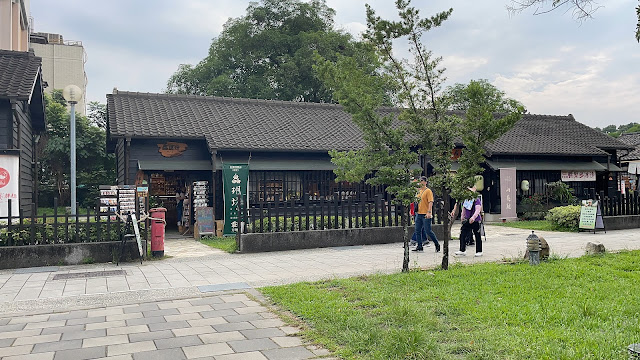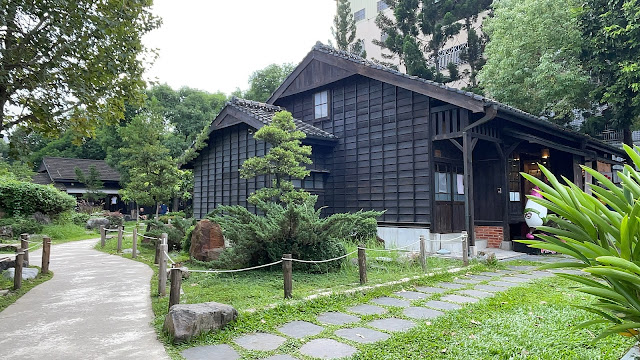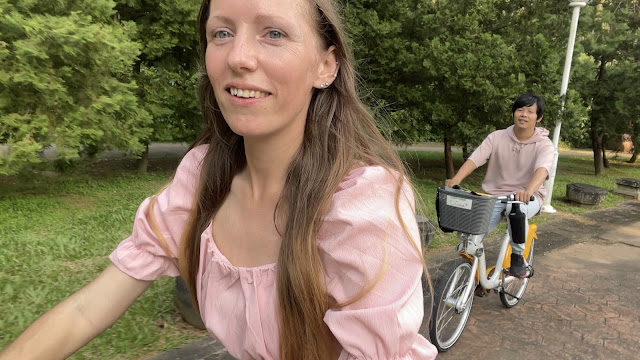Travel Date: 2024/10/11
During the 10.10 long weekend (which wasn't truly a long weekend since Friday was a working day, but we took the day off), we visited Chiayi. Our adventure began in Fanlu Township, known for its persimmon production. I discovered something interesting: while Hsinchu is often recognized for its persimmons, particularly from Xinpu due to its unique sun-drying method, Chiayi actually has the largest persimmon production in Taiwan.
After exploring the persimmon processing, we headed to an indigenous village for a leisurely stroll. Later, we made our way to Chiayi City, where we revisited some famous landmarks, including the Chiayi Old Prison and Hinoki Village, a cluster of buildings from the Japanese era. We enjoyed a bike ride around the city, sampling the local delicacy of turkey rice and stopping by the intriguing turkey pedestrian crossing (stay tuned for more details on that!).
To wrap up the day, we rode our bikes around Chiayi Park, which is quite spacious and conveniently located near where we parked. It was a fun-filled day, but I must admit that Chiayi isn't particularly pedestrian or bike-friendly. Sidewalks are rare, so if you're not comfortable navigating roads alongside cars and scooters, this city might not be the best choice for you.
I've divided this trip into two posts. In previous one, I introduced the persimmons, while this one will cover attractions in Chiayi City. Be sure to check it out! [LINK]
Chiayi Old Prison (嘉義舊監獄)
The Chiayi Old Prison stands as a unique historical site in Taiwan, offering visitors a rare opportunity to explore a fully preserved prison complex dating back to the Japanese occupation era. Open to the public from Tuesday to Sunday with free entry and guided tours, the prison is not only a physical reminder of Taiwan’s past but also a culturally significant landmark that has been recognized as a national monument. For anyone visiting Chiayi, this site is a must-see, packed with history and symbolism.
Constructed between 1919 and 1922, the Chiayi Old Prison was built during Japan’s rule over Taiwan. While the prison endured damages from several major earthquakes during the 1920s and 1930s, it was repaired, and the complex expanded. After Taiwan was handed over to the Nationalist Government post-World War II, the facility was renamed "Taiwan Chiayi Prison" in 1947. By the 1990s, the prison had deteriorated, leading to its relocation to Lucao Township in 1994.
Initially considered for demolition, Chiayi Old Prison was declared a national monument in 2005, protecting it from destruction. A full restoration was completed by 2011, and the site now serves as the Prison Administration Museum, drawing both history buffs and tourists alike. Covering 3.66 hectares, the prison’s design reflects early 20th-century architectural sensibilities. A fan-shaped central platform serves as its core, with prison cells radiating outward. This layout not only showcased a practical use of space but was designed to enhance surveillance and control, illustrating how architecture was used to maintain order.
Among the 28 remaining buildings, visitors will encounter a variety of structures built from wood, brick, and reinforced concrete. The administrative section underwent various renovations over the years, including updates to the warden's room and other offices. The separation of male and female dormitories, reception rooms, and inspection areas reflect the hierarchical and highly structured life that existed within its walls.
The Chiayi Old Prison, having withstood earthquakes, societal transitions, and even near-demolition, now stands as a testament to Taiwan’s commitment to preserving its colonial heritage. This historic site is part of a broader cultural complex that includes the Prison Dormitory Group and Martial Arts Field, showcasing how this facility once functioned as a complete system.
For those interested in architecture, history, or Taiwan’s colonial evolution, a visit to the Chiayi Old Prison offers an immersive dive into the country's past. The experience of walking through the prison grounds reveals the transitions Taiwan has gone through, from its days as a Japanese colony to its modern-day identity.
Hinoki Village (檜意森活村)
Located in the East District of Chiayi City, Hinoki Village is Taiwan’s first forest-themed cultural and creative park. Spanning 3.4 hectares, this village celebrates Taiwan's forestry history from the Japanese occupation era while preserving the beauty of 29 historical buildings. Nestled in a tranquil environment, it offers visitors a serene atmosphere where culture, history, and nature converge.
The village's history is deeply intertwined with the development of the Alishan forestry industry, which began during Japanese rule. The Japanese built infrastructure to extract and process Alishan's rich timber resources, including the Alishan Forest Railway and the Chiayi Timber Plant. The village, constructed between 1914 and 1943, housed employees of the Taiwan Governor’s Office Forestry Office. Known as the Yinglin Institute, the dormitory group was designed as a traditional Japanese village, with homes and public facilities that provided staff and their families with everything they needed.
Hinoki Village's architectural charm comes from its traditional Japanese-style buildings, with wooden frames, tiled roofs, and quaint gardens. The historical value of these structures was recognized in 2005 when many of the dormitories were designated as Chiayi City Historic Buildings. Today, the village preserves 29 of these dormitories, offering a glimpse into the lives of forestry workers and officials during the occupation period.
Beyond its historical allure, Hinoki Village has transformed into a vibrant cultural and creative hub. Visitors can explore artisan shops, cafes, and galleries that showcase Taiwan’s cultural heritage and craftsmanship. The park regularly hosts workshops, exhibitions, and events that keep its cultural and creative energy alive. Whether you’re a history enthusiast, art lover, or simply in search of a peaceful retreat, Hinoki Village offers something for everyone.
Chiayi Park & Sun-Shooting Tower
The park was established in 1910, and was originally named "Chiayi Park. The name was changed to "Zhongshan Park" after the KMT government arrived in Taiwan but was reinstated to its original name in 1997.
Chiayi Park is located in the suburban area of eastern Chiayi City. It was first developed along the hilltop landscape, and later, vacant lands to the east and west were incorporated into the park. Bridges were constructed, and roads were built to enhance accessibility. The park now spans over 268,000 square meters and features tall, old trees, waterside pavilions, terrace houses, fish ponds, rockery decorations, and winding pathways that lead to secluded corners. The design of the park makes excellent use of the original natural landscape to create tasteful scenery and a free, unfettered ambiance.
The park is home to many historic sites, including the Martyrs' Shrine, Chiayi Tower, Fukang-an Monument, Bingwu Earthquake Monument, twelve ancient cannons, the Tan Ting-pho Easel, the Way of the Wall, Yijiangshan Monument, Confucius Temple, and the national treasure, the Alishan Forest Railway No. 21 steam locomotive. This makes the park a great place to visit for the general public. Additionally, the densely wooded forestry and agricultural research institute branches located in the northeastern corner of the park boast a wide variety of tropical plants and are well worth a visit.
Sun-Shooting Tower
Standing at 62 meters high, the design of the Sun-Shooting Tower was inspired by the giant trees of Alishan, with brownish aluminum stripes symbolizing the texture of the giant trees' outer surface. In the middle of the tower is a 40-meter tall "one-line sky," along with a bronze sculpture inspired by the "sun shooting myth" of the indigenous people. This beautiful myth symbolizes the heritage of humanity, reflecting the spirit of advancing towards the future while conveying positive meanings in a social and educational context.
At the entrance of the tower, a pair of copper sculptures of clouded leopards symbolize the tutelary god of Formosa. The Martyrs' Shrine is located on the bottom level of the tower, while the top features a café and a watchtower. The beautiful and eye-catching giant city flower—Bauhinia blakeana, or the Hong Kong Orchid Tree—sits on the inclined roof at the tower's tip, attracting the attention of passersby. Visitors can enjoy a panoramic view of the entire Chiayi City from the tower’s top, appreciating the picturesque scenery of the mountain city in one glance.
Chiayi Historical Relic Museum (Kagi Shrine (嘉義神社))
The Kagi Shrine in Chiayi is a fascinating site that represents both the cultural and historical evolution of the city. Originally a sacred Shinto shrine established by the Japanese during their colonial rule in Taiwan, it stands as a testament to the layers of transformation Chiayi has undergone—first under Qing rule, then during the Japanese occupation, and finally into its post-war modern identity.
Chiayi, home to the Indigenous Hoanya people, saw the arrival of Han Chinese settlers in the 16th and 17th centuries, which brought significant changes to the area. Under Qing rule, the city grew in importance as a port and a hub for settlers from Fujian Province. However, it was under Japanese colonial rule, following the First Sino-Japanese War (1895), that Chiayi underwent rapid modernization. During this period, the Japanese sought to develop Taiwan as a model colony, and Chiayi (then known as "Kagi") became central to this vision, especially in agricultural production, timber, and sugar industries.
The construction of the Alishan Railway was a key factor in boosting the local economy, allowing the efficient transport of resources like timber and agricultural products. As the city grew, so did its infrastructure, and the Kagi Shrine was constructed in 1915 to cater to the spiritual needs of the Japanese settlers, reflecting both cultural and religious influences.
Kagi Shrine’s Architectural and Cultural Significance
Initially built from Alishan cypress wood by master craftsman Mitsuru Ito, Kagi Shrine quickly became a cultural and religious center. It was upgraded just two years after its establishment, signifying its importance in the community. However, by the 1930s, the first generation of the shrine had suffered significant termite damage, necessitating a rebuild. The second-generation shrine, completed in 1943, was more robust and catered to the growing population of Chiayi, securing its status as one of Taiwan's three Minor National Level Shrines.
The architecture of Kagi Shrine was distinctly Japanese, employing traditional styles like irimoya-zukuri and shoin-zukuri, blending temple and residential design elements. The shrine’s use of cypress wood not only tied it to the local Alishan forest but also ensured it fit the aesthetic and spiritual needs of the Japanese community. Key architectural features included decorative roofing tiles like onigawara and hiragawara, which served both protective and ornamental purposes.
After World War II and the return of Taiwan to Chinese control, the shrine was repurposed into a Martyrs Shrine, commemorating the heroes of the Republic of China. Although much of the original shrine was destroyed by a fire in 1995, many elements, such as the Visiting Path (sando), stone lanterns, and komainu (lion-dog) statues, remain intact, preserving the site’s spiritual symbolism.
Present Day and Chiayi Park
Today, Chiayi Park, where Kagi Shrine once stood, is a popular cultural destination. The remnants of the shrine provide a glimpse into its former grandeur, with several key features like the stone lanterns, komainu guardians, and the Purification Fountain (chozuya) still in place. The Purification Fountain, dating back to 1945, is an especially significant element, symbolizing the spiritual transition from the profane to the sacred.
The Administration Office and Priests Hall, some of the best-preserved structures from the shrine, offer visitors a rare opportunity to experience the traditional Japanese architectural styles that dominated during the shrine’s peak. These buildings, with their thoughtful design adapted to Taiwan’s tropical climate, remain important cultural landmarks. The intricate craftsmanship, use of local materials like Alishan cypress, and the practical innovations (such as cement bases to prevent termite damage) all reflect the Japanese architects' responses to the challenges posed by Taiwan's environment.
The Purification Fountain (chozuya), built in 1945, remains one of the most authentic and well-preserved elements of the Kagi Shrine. Traditionally used for ritual cleansing before entering the sacred grounds, visitors would wash their hands and mouths to purify themselves spiritually. The fountain’s cypress roof reflects the skilled craftsmanship of the time, incorporating decorative details such as Gegyo—fish-shaped charms meant to protect the structure from fire, a significant concern in wooden buildings. These charms not only served a practical purpose but also added to the shrine's aesthetic and spiritual symbolism.
The Resting Pavilion, although altered over the years, retains its cement base and pillars, providing a shaded retreat for visitors. Originally designed to accommodate Chiayi's tropical climate, this structure offered a place for rest, reflection, or shelter from the sun. While the pavilion may no longer exist in its complete original form, these surviving elements still offer insight into how the shrine’s architecture was designed to blend function with comfort for visitors.
Today, Chiayi Park not only honors this rich history but also features modern attractions like the Sun-Shooting Tower and the Chiayi Park and Showa 18 Relic Museum, where visitors can explore exhibitions detailing the shrine's history. The park’s evolution from a religious center to a public heritage space encapsulates the broader transformation of Chiayi itself, blending its colonial past with its modern identity.
%202%20(1).jpg)


































0 komentarze:
Post a Comment